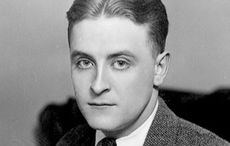| Joe Cunningham (seated) feted for turning 100 in Yonkers. Pictured left are Hanora O’Dea Kilkenny and (kneeling) Irish Consul General Noel Kilkenny. |
Joe’s span in the New York Irish traditional music scene was highlighted by his own playing and his work with the historically more well-known Michael Coleman and James Morrison from Sligo, whose recordings helped stoke the revival of the genre back in Ireland and also establish it here for the many Irish immigrants.
His longevity and sharp memory right up to the end made him a go-to source for researchers like Harry Bradley and Martin Enright for information. He made significant contributions to the Sligo/New York history as witnessed by visits to the Morrison Teach Cheoil in Riverstown, Co. Sligo in recent years as a contemporary of Coleman, Morrison, Paddy Killoran, Lad O’Beirne and Martin Wynne.
Cunningham was the oldest living member of the County Clare PB and S Association of New York, and married for 64 years to his wife Rose O’Donnell (from Drumkerrin, Co. Leitrim) who is in St. Patrick’s nursing home.
They were prominently profiled as Irish emigrants able “To Love Two Countries” as loyal members of the Aisling Irish Center on McLean Avenue in Yonkers. Earlier this year a centennial celebration occurred at the Kerry Hall in Yonkers.
Cunningham passed away on December 13, and was laid to rest after Mass at St. Barnabas Church in Woodlawn on Tuesday, December 18.
Back in Ireland, the iconic Clare singer and song writer from Spancil Hill, Robbie McMahon departed this life the same day at the age of 86 after a brief illness and was laid to rest Kilroughhtis Cemetery on Sunday after a Mass at the parish church at Clooney.
While he didn’t write the famous ballad of emigration “Spancil Hill” (Michael Considine did in the 19th century), McMahon’s was the quintessential version filled with colorful verses not usually heard in the well-covered song because of his own association with the fair town of Spancil Hill.
Full of devilment and social commentary, McMahon did craft thoughtful and poetic songs that evoked the lives and times of his locality and Ireland in general, like the “Red Cross Social” and the name-dropping epic “Fleadh Down in Ennis” about the first Fleadh Cheoil na hEireann in 1955 held in Clare.
Like “Spancil Hill” and the “Bard of Armagh,” McMahon could interpret songs penned by others brilliantly and not only collected them but encouraged their sharing at monthly singing sessions in his local pub Duggan’s in Spancil Hill or at festivals and fleadhs around the country. Several years ago I marveled at his ability to keep a singing session going for hours with great variety at the Tulla Trad Festival as he worked the room for talent and party pieces.
Thankfully the archival preservationists at the Comhaltas resource center Cois na hAbhna in Ennis, Frank Whelan and Joe O’Connor, decided that McMahon’s legacy was worth capturing in a video documentary which was produced two years ago called Last Night As I Lay Dreaming.
Just last month a companion CD with the music and songs from the DVD was launched in Ennis for the singer who was honored by Clare County Council with a civic reception in 2010 for his exceptional contributions to the Banner County. Ar dheisDe go raibh a anam dilis.
To purchase the DVD and/or the CD contact www.coisnahabhna.ie.




Comments